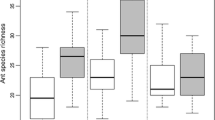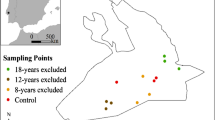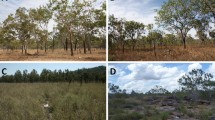Abstract
Grazing by domestic livestock is one of the most widespread forms of anthropogenic disturbance globally, and can have a major impact on biodiversity and therefore conservation values. Here we use ants to assess the extent to which livestock grazing is compatible with biodiversity conservation in a tropical savanna of northern Australia, where there is growing pressure to intensify pastoral production. We focus on the extent to which ant responses conform with four general patterns identified in a recent global review: (1) soil and vegetation type have a far bigger impact on ant community composition than does grazing; (2) grazing modifies ant species composition but often not species richness or total abundance; (3) a species’ response often varies among habitats; and (4) between 25–50% of the species that can be statistically analysed are responsive to grazing. We sampled ants using pitfall traps at 38 sites in two land systems, based on cross-fence comparisons of areas of different grazing intensities. A total of 130 ant species from 24 genera were recorded, with the fauna dominated by species of Iridomyrmex and Monomorium. Land system was the primary driver of variation in ant species richness and composition, and grazing intensity was related to neither species richness nor total abundance. Only 10% of common species appeared to be impacted by grazing. Overall, ant responses to grazing in our study region were generally consistent with the four global patterns, except that the local fauna seems to be particularly resilient. Such resilience indicates that current grazing management practices are compatible with the conservation of ant biodiversity.






Similar content being viewed by others
References
Abensperg-Traun M, Smith GT, Arnold GW, Steven DE (1996) The effects of habitat fragmentation and livestock-grazing on animal communities in remnants of gimlet Eucalyptus salubris woodland in the Western Australian wheatbelt. II. Arthropods. J Appl Ecol 33:1281–1301
Andersen AN (1995) A classification of Australian ant communities, based on functional groups which parallel plant life-forms in relation to stress and disturbance. J Biogeogr 22:15–29
Andersen AN (2000) The ants of northern Australia: a guide to the monsoonal fauna. CSIRO Publishing, Collingwood
Andersen AN, Majer JD (2004) Using invertebrates as bioindicators in land management: ants show the way Down-Under. Front Ecol Environ 2:291–298
Andersen AN, Azcárate FM, Cowie ID (2000) Seed selection by an exceptionally rich community of harvester ants in the Australian seasonal tropics. J Anim Ecol 69:975–984
Andersen AN, Parr CL, Lowe LM, Müller WJ (2007) Contrasting fire-related resilience of ecologically dominant ants in tropical savannas of northern Australia. Divers Distrib 13:438–446
Andersen AN, Del Toro I, Parr K (2015) Savanna ant species richness is maintained along a bioclimatic gradient of increasing latitude and decreasing rainfall in northern Australia. J Biogeogr 42(12):2313–2322
Anderson MJ, Gorley RN, Clarke KR (2008) PERMANOVA+ for PRIMER: guide to software and statistical methods. PRIMER-E, Plymouth
Ash AJ, Corfield JP (1998) Influence of pasture condition on plant selection patterns by cattle: its implications for vegetation change in a monsoon tallgrass rangeland. Trop Grasslands 32:178–187
Ash AJ, McIvor JG, Mott JJ, Andrew MH (1997) Building grass castles: integrating ecology and management of Australia’s tropical tallgrass rangelands. Rangeland J 19(2):123–144
Australian Government Department of Environment (2015) Conservation management zones of Australia—North Australian Tropical Savanna. https://www.environment.gov.au/system/files/resources/cdae9dcc-7af7-4cb5-85fe-f4c9100e913d/files/cmz-north-australian-tropical-savanna.pdf. Viewed 13 Dec 2015
Australian Government Department of the Prime Minister and Cabinet (2015) Our North, our future: white paper on developing Northern Australia. https://www.cdu.edu.au/sites/default/files/the-northern-institute/docs/northern-australia-white-paper.pdf. Viewed 15 Dec 2015
Barragán F, Moreno CE, Escobar F, Bueno-Villegas J, Halffter G (2014) The impact of grazing on dung beetle diversity depends on both biogeographical and ecological context. J Biogeogr 41:1991–2002
Boulton AM, Davies KF, Ward PS (2005) Species richness, abundance, and composition of ground-dwelling ants in northern California grasslands: role of plants, soil, and grazing. Environ Entomol 34(1):96–104
Bureau of Meteorology (2015) Bureau of Meteorology Australia website: http://www.bom.gov.au/jsp/ncc/cdio/weatherData/av?p_nccObsCode=139&p_display_type=dataFile&p_stn_num=014647. Retrieved 15 Aug 2015
Castracani C, Grasso DA, Fanfani A, Mori A (2010) The ant fauna of Castelporziano Presidential Reserve (Rome, Italy) as a model for the analysis of ant community structure in relation to environmental variation in Mediterranean ecosystems. J Insect Conserv 14:585–594
Cowley T, Cameron A, Northern Territory and Department of Primary Industry and Fisheries (2014) The 2010 Pastoral Industry Survey: Katherine Region. Northern Territory Government, Darwin
Crawley MJ (1983) Herbivory. The dynamics of animal–plant interactions. Blackwell Scientific Publications. Nature 405(6783):234–242
Delsinne T, Roisin Y, Herbauts J, Leponce M (2010) Ant diversity along a wide rainfall gradient in the Paraguayan dry Chaco. J Arid Environ 74:1149–1155
Dolédec S, Phillips N, Scarsbrook M, Riley RH, Townsend CR (2006) Comparison of structural and functional approaches to determining land use effects on grassland stream invertebrate communities. J N Am Benthol Soc 25(1):44–60
FAO (1997) The State of Food and Agriculture 1997. Food and Agriculture Organization of the United Nations (FAO), Rome. Web version: http://www.fao.org/docrep/w5800e/w5800e00.htm
Fisher A (2001) Biogeography and conservation of Mitchell grasslands in northern Australia. (Unpublished Ph.D. thesis). Charles Darwin University, Northern Territory, Australia
Grandin U, Lenoir L, Glimskär A (2013) Are restricted species checklists or ant communities useful for assessing plant community composition and biodiversity in grazed pastures? Biodivers Conserv 22:1415–1434
Hoffmann BD (2000) Changes in ant species composition and community organisation along grazing gradients in semi-arid rangelands of the Northern Territory. Rangeland J 22:171–189
Hoffmann BD (2003) Responses of ant communities to experimental fire regimes on rangelands in the Victoria River District of the Northern Territory. Aust Ecol 28(2):182–195
Hoffmann BD (2010) Using ants for rangeland monitoring: global patterns in the responses of ant communities to grazing. Ecol Indic 10:105–111
Hoffmann BD, Andersen AN (2003) Responses of ants to disturbance in Australia, with particular reference to functional groups. Aust Ecol 28:444–464
Hoffmann BD, James CD (2011) Using ants to manage sustainable grazing: dynamics of ant faunas along sheep grazing gradients conform to four global patterns. Aust Ecol 36:698–708
Hoffmann BD, Griffiths AD, Andersen AN (2000) Responses of ant communities to dry sulphur deposition from mining emissions in semi-arid tropical Australia, with implications for the use of functional groups. Aust Ecol 25(6):653–663
Laycock WA (1991) Stable states and thresholds of range condition on North American rangelands: a viewpoint. J Range Manag 44:427–433
Lee KE (1977) Physical effects of herbivores on arid and semi-arid rangeland ecosystems. In: The impacts of herbivores on arid and semi-arid rangelands. Proceedings of the 2nd United States/Australia Rangeland Panel, Adelaide, 1972. Australian Rangeland Society, Perth, pp 173–186
Lorimer MS, Schoknech NR (1987) A study of the land in the Campaspe River catchment. http://vro.agriculture.vic.gov.au/dpi/vro/nthcenregn.nsf/0d08cd6930912d1e4a2567d2002579cb/1fbd76e80475cfc4ca2575270026cd98/$FILE/campaspe%20ch7.pdf. Viewed 23 May 2016
MEA (2005) Millennium Ecosystem assessment. Ecosystems and human well-being: scenarios, vol 2. Island Press, Washington, DC
Petit C (2011) Sturt Plateau District: understanding the productivity of grazing lands—land condition guide. Northern Territory Government, Darwin
Poyry J, Lindgren S, Salminen J, Kuussaari M (2004) Restoration of butterfly and moth communities in semi-natural grasslands by cattle grazing. Ecol Appl 14:1656–1670
Schmidt AC, Fraser LH, Carlyle CN, Bassett ERL (2012) Does cattle grazing affect ant abundance and diversity in temperate grasslands? Rangeland Ecol Manag 65:292–298
Shattuck SO (1999) Australian ants: their biology and identification. CSIRO Publishing, Melbourne
Tongway DJ, Ludwig JA (2011) Restoring disturbed landscapes: putting principles into practice. Island Press, Washington, DC
Waudby HP, Petit S (2015) Small Australian desert vertebrate responses to grazing intensity during La Niña. Ecol Res 30:715
Woinarski JCZ, Andersen AN, Churchill TB, Ash A (2002) Response of ant and terrestrial spider assemblages to pastoral and military land use, and to landscape position, in a tropical savanna woodland in northern Australia. Aust Ecol 27:324–333
Woinarski J, Mackey B, Nix H, Traill B (2007) The nature of Northern Australia: natural values, ecological processes and future prospects. Australian National University Press, Canberra
Yadamsuren O, Hayford B, Gelhaus J, Ariuntsetseg L, Goulden C, Podenas S, Podeniene V (2015) Declines in diversity of crane flies (Diptera: Tipuloidea) indicate impact from grazing by livestock in the Hövsgöl region of Mongolia. J Insect Conserv 19:465–477
Acknowledgements
We thank property managers Garry and Michelle Riggs for allowing the research to be conducted on their property, and for being such supportive hosts. We also thank Leigh Hunt for advice on classifying the sites in relation to grazing intensity, Jodie Hayward, Asier Zabaleta, Julie Louvrie, Charlotte Bigard and Alex Cussonneau for field and laboratory assistance, Ben Hoffmann and Leigh Hunt for their constructive comments on the manuscript and Keith McGuinness and Mirjam Kaestli for statistical advice. GBA received funding support from the Brazilian program Science without Borders from CNPq (Conselho Nacional de Desenvolvimento Científico e Tecnológico), process number 236918/2012-5. This study was also supported by Charles Darwin University and CSIRO.
Author information
Authors and Affiliations
Corresponding author
Ethics declarations
Conflict of interest
The authors declare that they have no conflict of interest.
Additional information
Communicated by Jan C Habel.
Electronic supplementary material
Below is the link to the electronic supplementary material.
Rights and permissions
About this article
Cite this article
Arcoverde, G.B., Andersen, A.N. & Setterfield, S.A. Is livestock grazing compatible with biodiversity conservation? Impacts on savanna ant communities in the Australian seasonal tropics. Biodivers Conserv 26, 883–897 (2017). https://doi.org/10.1007/s10531-016-1277-5
Received:
Revised:
Accepted:
Published:
Issue Date:
DOI: https://doi.org/10.1007/s10531-016-1277-5




